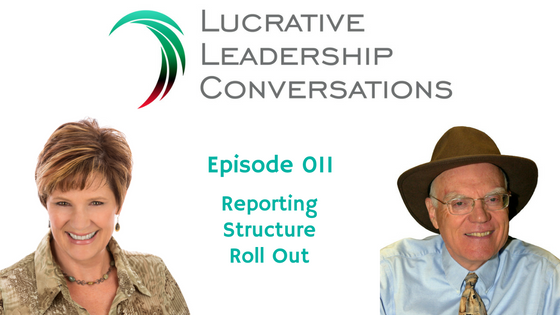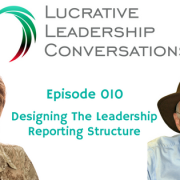011 | Reporting Structure Roll Out
In the last episode of the Lucrative Leadership Conversations podcast (you can listen here), Gene and I discussed how leaders undergo a creative process to design a new reporting structure design.
This is Step 5 in Gene’s Leaders First Process, an innovative organizational design that creates the foundation for a learning organization, adding clarity and focus based on negotiated accountability.
Here’s a recap of each step:
- Leaders agree to their own personal responsibilities to ensure decisions protect the organization’s best interest.
- The leadership team crafts a common language, which we call “outcomes, that expresses the core competencies synergistic with the strategic vision.
- Leaders negotiate who, on the leadership team, will have the primary accountability for designing and executing each outcome.
- Working together, the leaders begin an intuitive process to collaborate and design a structure they are able to support and explain to others. Leaders decide their roles for each outcome and agree how and when communications occur that define future and past actions and decisions. They create the first drafts of the reporting structure.
In today’s episode, we dive into to the steps of rolling out the structure. Engaging the entire organization in ongoing discussions improves the design. Conversations serve to clarify and reinforce the meaning of the outcomes that make the organization sustainable.
What Are Some Goals of A Successful Roll Out?
- Leaders learn how best to communicate the reporting structure to others, i.e. to identify the pitfalls in their communication process.
- To gain workforce members’ agreements to implement the structure in their daily work routines.
- Educate the workforce about how to perform within the new leadership and the reporting structures.
- Build support and interest in accomplishing the strategic vision.
- Test what the workforce sees that the leaders have missed, i.e. to discover the unseen vulnerabilities of the reporting structure.
Why The Reporting Structure is Foundational to Enhancing Employee Engagement
- It creates a link to their role in the the strategic vision of the organization.
- Reporting Structure clarifies the different outcome delivery teams.
- Employees better understand the company’s priorities, improving their ability to make better decisions
- They understand who has the authority to proceed.
- Knowing the proper method to lodge a complaint, resolve a dispute, and mediate a conflict.
- How employees can be expected to work with others outside their function or expertise.
- Ways to communicate/collaborate with other parts of the organization.
How Do Leaders Roll Out Their New Reporting Structure?
- Reporting structure design is a reflection of the new leadership structure.
- Leaders take the initiative to reality test the structure in presentations to the workforce.
- As the workforce is informed they interact with the leaders over what they like, what they don’t understand, and what they think needs a redesign.
- The leaders revise the reporting structure where needed and work through a process to present and publish it.
What Are The Leader Perspectives In A Rollout?
Leaders group takes the initiative to reality test the structure in presentations to the workforce.
Leaders explain:
- What stimulated the need for new leadership and reporting structures.
- How they intend to work within the leadership structure.
- The goals of the structure.
- How it relates to the strategic vision and its priorities.
- What is new and why it is included.
- Why it is important for the workforce to learn the reporting structure.
- How workforce members can put it to productive use.
Leaders learn:
- How to explain the structure to the workforce.
- What they might have missed in their strategic design.
- New ways to think about it themselves.
- If the intent of the reporting structure can be understood.
What Are Some Important Employee Perspectives During A Rollout
- The workforce meets with leaders to understand its implication for them.
- The meeting follows an inclusive and informative agenda.
- They ask questions for clarification.
- Their observations and suggestions are written for all to verify the employee’s comments are accurately recorded.
- They give input and suggestions to the leaders that:
- Improves and enhances the role of reporting structure, improving clarity and focus.
- Allows conversations about the improvements they would like to see, and how best to communicate the structure to others including customers and suppliers.
When Is A Reporting Structure A Success?
When those who work in it…
- Able to accept more growth:
- Outcome delivery is easier and the volume of outcomes delivered increases with the same number of people and the same amount of resources.
- They have less stress performing their work and better working relationships across function, product, or project lines.
- Silos are a thing of the past.
- When customer and supplier measures of satisfaction are constantly improving.
- When the leaders recognize meaningful progress on their strategic priorities.
In next week’s episode, we’ll explain the process for tracking performance linking leading indicators to financial results. Until then, here’s to leading together!
About the Hosts:
SUSAN HASTY

Susan Hasty is the CEO of 360 Profit Masters and the host of the Lucrative Leadership Conversations podcast. Susan considers herself a “maverick leader” on a mission to inspire and equip leaders to ignite their leadership genius. Susan co-founded 7 business ventures over the last 35 years. Her passion is helping business owners and CEOs improve their own clarity, focus and commitment to build more sustainable organizations empowered to make economic liberty a reality. She is certified in Neurolinguistic Programming and is a Strategic HR Business Partner by the Human Capital Institute. She is a member of the Marshall Goldsmith Stakeholder Centered Coaching Network of International Leadership coaches.
Ready to your business more profitable? Schedule a free call with Susan Hasty
GENE MORTON
 Gene Morton is an organizational psychologist based out of Colorado. He is also an award winning author of the book, Leaders First: Six Bold Steps to Sustain Breakthroughs in Construction. Over the past 40 years, Gene has consulted on more than 100 projects in 85 organizations with leader groups engaged in complex mergers, reorganizations, leadership turnarounds, and system redesigns.
Gene Morton is an organizational psychologist based out of Colorado. He is also an award winning author of the book, Leaders First: Six Bold Steps to Sustain Breakthroughs in Construction. Over the past 40 years, Gene has consulted on more than 100 projects in 85 organizations with leader groups engaged in complex mergers, reorganizations, leadership turnarounds, and system redesigns.
He developed the Leaders First Alignment Process to provide leadership teams the model they need to gain clarity as the organization evolves. His passion is mastering the complexities of organized and collaborative leadership.
Connect With Us
Subscribe to itunes Subscribe to stitcher Subscribe to Google Play
Straight forward leadership advice
Learn a simpler, more practical approach to building your leadership team strength... Delivered straight to your inbox!




